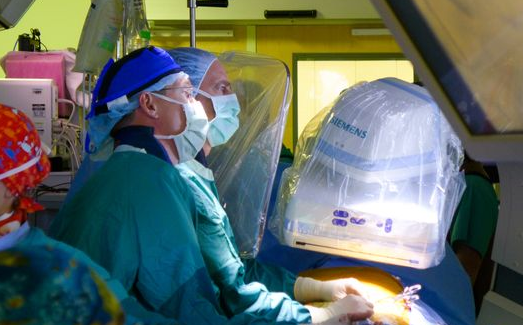Inch by inch, two doctors working side by side in an operating room guide a long narrow tube through a patient’s femoral artery, from his groin into his beating heart. They often look intently, not down at the 81-year-old patient, but up at a 60-inch monitor above him that’s streaming pictures of his heart made from X-rays and sound waves.
The big moment comes 40 minutes into the procedure at Morton Plant Hospital. Dr. Joshua Rovin unfurls from the catheter a metal stent containing a new aortic valve that is made partly out of a pig’s heart and expands to the width of a quarter outside the catheter. The monitor shows it fits well over the old one. Blood flow is normal again. “This is pretty glorious,” Rovin said.
The surgeon has performed one of the fastest-growing procedures in U.S. heart care known as a transcatheter aortic valve replacement, or TAVR. The operation was approved in the U.S. in late 2011 to help patients too ill or frail for traditional “open-heart” valve surgery. The procedure has rapidly gained doctors’ acceptance, particularly for patients in their 80s and 90s.For hospitals like Morton Plant, the new valve technology comes at a fortuitous time – just as they confront rapidly falling demand for one of their most lucrative heart procedures, coronary artery bypass surgery. That has been used for more than 40 years to restore blood flow around blocked arteries, but less invasive treatments such as angioplasty have gained favor.
The opposing trends – fewer bypasses, more valve surgeries – demonstrate the hospital industry’s record of finding new ways to fill beds and increase revenue even as advances in health and technology shrink demand for inpatient care. “Hospitals are like investment bankers, they are always looking for the next big deal and in this regard the next big deal is valve surgery,” said Gerard Anderson, director of the Johns Hopkins University Center for Hospital Finance and Management.
Valve surgery has risen more than 50% since 2012; the annual totals bolstered partly by more TAVR procedures, according to estimates from Frost & Sullivan, a consulting firm. About 16,000 TAVRs were done last year and hospitals are on pace to perform at least 20,000 in 2015, according to a national TAVR registry kept by two major medical groups.
But as with other new medical technology, TAVR draws concerns about possible overuse or adoption by hospitals lacking proficiency, which could harm patients and increase health care costs.
x

No Comment to " New hope beats for heart patients and hospitals "